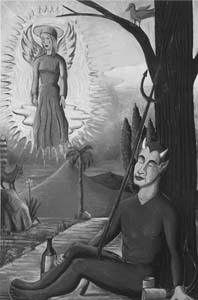![[Metroactive Arts]](/arts/gifs/art468.gif)
[ Arts Index | Metro | Metroactive Central | Archives ]
In the 'Haus' of Funk
Kelly Detweiler toys with pop-culture images in his new show at ICA
By Ann Elliott Sherman
FOR ALL ITS SUPPOSED irreverence, the brand of funk art germinated at UC-Davis during the late '70s was about as outrageous as a frat-house skit. Only within the context of a white-bread (excuse me, whole-grain) quasi-bucolic retreat from urban strife could a ceramic hamburger pass for cutting edge.
Seeking refuge from the indentity-driven cultural movements of the day, many hip, ambitious white guys in the art department started taking on the sacred cows of Western art history and/ or Americana while pretending not to take themselves too seriously. The first target allowed them to display the technical chops required to survive often-brutal critiques, the latter to display the right blend of smug removal and down-home embrace of popular culture.
The visual puns, appropriated kitsch and folksy reference points married with "high art" that fuel this bad-boy genre are a lot like David Letterman's humor. What was once college-educated yet anti-intellectual wise-guy wit has become the marketed mainstream, coasting on its own momentum for far too long to garner more than an occasional weak smile.
Selections From the Bau Wau Haus, now on display at the San Jose Institute of Contemporary Art, has its moments, but the exhibit does little to counter that perspective. Despite the demands of chairing Santa Clara University's art department, Kelly Detweiler has been amazingly prolific, as an entire gallery crammed full of works attests.
Detweiler paints in a hallucinogenically vivid, flattened style familiar to underground-comics aficionados. Unlike actual cartoonists, however, he politely avoids truly transgressive or overtly incisive content. Thickets of barren trees, stacks of biomorphic boulders and purple mountains' majesty bathed in irradiating sunlight create recurrent, subliminally emotional landscapes often as devoid of carbon-bearing life as a planet wasted in a neutron winter.
Elsewhere, as in Conspiracy Theory, lone little pink houses guarded at the door by single women become a point of convergence for various recurring icons from Detweiler's bag of kitsch: stogey-chomping clowns, chirping birds, a ring-tailed squirrel, an organ grinder and a frog cribbed from Mexican tourist-trap ceramics. It's the American dream of tasteful hearth and home under attack.
Interestingly, the sharpest point to Detweiler's shtick comes in a variation on the above theme titled The Uninvited Guest. The titular figure is actually a little sombreroed, guitar-playing frog come to perform a moonlight serenade, but the lady of the pink house answers this romantic gesture by coming out wielding a kitchen knife.
Whether The Uninvited Guest is a misogyny-tinged commentary on heterosexual relations in the post-feminist age or a parody of anti-immigrant hostility is open to debate, but the menacing tension saves this painting from being yet another sendup that goes nowhere.
A WRY, INVERTED RIFF on "Devil With the Blue Dress," Dreaming of a Blue Angel shows a sleeping red devil resting his pitchfork and pointy tail against a bare tree. The apparition of Satan's unobtainable desire floats in a Day-Glo sunset sky borrowed from a black-velvet painting.
She is not Marlene Dietrich but one of the heavenly host modestly robed in blue. If not for the addition of Detweiler's squirrel alter ego and a bluebird, Dreaming might have been created by a mute and tranquilized Manuel Ocampo.
In addition to the paintings, Detweiler has created numerous wood sculptures that resemble a shotgun marriage between fellow SCU faculty member Sam Hernandez's abstracted geometric figures and cheesy, appropriated "primitive" carvings and serving dishes from Mexico or Hawaii.
These disparate elements are overlaid with different paint finishes, ranging from gilded Cubist geometrics to cloud-fleeced landscapes. Painted monkey pods and fake fruit make for some truly animated masks, but whether Detweiler intended the Totem of tiki mugs and pineapple bowls topped with a wahini figurine as a spoof of or an homage to retro-lounge cool, the result is just lamely sophomoric.
Fishin for Meaning turns a fisherman statue's pole into a feather-tipped pen (a dig at art writers' old-fashioned insistence on finding significance where none exists?), but in most of these pieces Detweiler seems content just to slap a bit of gold paint on flea-market exotica.
Unlike Jeffrey Koons' mocking elevation of kitsch to an exquisitely crafted objet d'art that only the wealthy can afford, Detweiler's pieces don't work both sides against the middle. The result is that one can too readily escape any sense that the joke is on them. Everyone is let off too easy for these works to qualify as "profound" satire.
Detweiler's third group of pieces falls somewhere between the full-sized paintings and the sculptures. They consist of little paintings turned into theatrical backdrops for shelves displaying embellished found objects.
This familiar mixed-media strategy mostly recycles Detweiler's trademark motifs on a different scale, but the desolate birch trees paired with an unblinking, shell-eyed monkey carving dubbed All Alone--as well as Atlas wobbling with one foot in an off-balance wooden shoe--do inspire a cruel snort. Maybe the muzzle and leash will be off in the next batch from the Bau Wau Haus.
[ San Jose | Metroactive Central | Archives ]
![]()
 Devilish Thoughts: A besotted demon is 'Dreaming of a Blue Angel' in a detail from one of Kelly Detweiler's large canvases at the San Jose Institute of Contemporary Art.
Devilish Thoughts: A besotted demon is 'Dreaming of a Blue Angel' in a detail from one of Kelly Detweiler's large canvases at the San Jose Institute of Contemporary Art.
Kelly Detweiler: Selections From the Bau Wau Haus runs through Jan. 9 at the San Jose Institute of Contemporary Art, 451 S. First St., San Jose. (408/283-8155)
From the December 24-30, 1998 issue of Metro.